Planet earth is home to millions of species of animals adapted to live in different habitats. Habitat is the natural and ecological environment that provided the species with food, shelter and protection.
Habitats are classified broadly into two types terrestrial and aquatic. Animals that live predominantly on land for their survival are called terrestrial, while those that live in water are called aquatic. Some animals can survive on both land and in water and are known as amphibians.
Terrestrial animals range from different sizes and prefer to reside in their habitat, some are large herbivorous that feeds upon trees, grasses and fruits and some are carnivorous that feeds on meat, bones and blood of other animals.
Some animals are strong due to their sheer size and brutal strength while some animals have a fierce reputation of standing their grounds even when challenged by an animal much larger than its size.
Check out the list of five fearless terrestrial animals:
Top 5 Fearless Land Animals
 Komodo Dragon: Komodo dragon is the largest species of lizard measuring 10 ft and can weigh up to 70 Kgs. Their large size and fierce reputation make them one of the fearless animals. They have a long and powerful tail.
Komodo Dragon: Komodo dragon is the largest species of lizard measuring 10 ft and can weigh up to 70 Kgs. Their large size and fierce reputation make them one of the fearless animals. They have a long and powerful tail.
They have thick armoured scales in their body and powerful claws. They possess venomous bite due to the presence of several toxic proteins and septic bacteria, and a single bite is enough to paralyze their prey.
Komodo dragons prefer dry and hot open places like savannah, grasslands and tropical forests. They are carnivorous, their hearing and night vision capability is poor, and they have a life-span of about 30 years. They depend upon their forked tongue to gather the information of their surroundings and can detect prey from 9 km away.
They ambush live prey with a stealthy approach and try to kill out their prey. They can kill large pigs and deer within seconds with their large tail. They can eat 80% of their body weight at one go but have a slow digestive metabolism, and they lay down in the sun to speed up their digestive metabolism.
Komodo dragons occasionally attacked humans, size and strength of the opponent do not matter to them as they are fully aware of their attack and defensive mechanism.
They tend to stand their ground when challenged and can stand on their powerful hind legs and deliver a severe blow with their sharp claws of their forelegs like a wrestling match.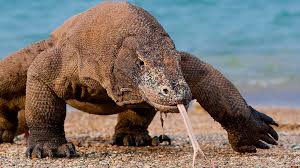
 Hippopotamus: A hippopotamus is a large herbivorous, semi-aquatic and hairless animal, weighing up to 1500 kgs on an average. It has been found that some males can weigh as much as 3500 to 4000 kgs.
Hippopotamus: A hippopotamus is a large herbivorous, semi-aquatic and hairless animal, weighing up to 1500 kgs on an average. It has been found that some males can weigh as much as 3500 to 4000 kgs.
Male hippos continue to grow throughout their entire lifetime. They have strong muscular bones and have a wide opening mouth. They have the largest canine teeth in the animal kingdom measuring 50 cms, these canines have no role in their feeding and used during combat only.
The skin of hippos is about two and a half inches thick and protects them from predators. Their skin secretes a natural sunscreen to protect their skin against disease-causing bacteria.
They prefer rivers, swamps and mangroves for their habitat as lack of hair in their body makes their skin vulnerable and require water to cool off their body temperature. They spend 16 hours a day on the water.
A hippopotamus is a territorial and extremely aggressive animal. Because of their unpredictability and aggression they are listed amongst the most dangerous animals of the world.
Despite short and stocky legs, they can run to a speed of 30 km an hour over short distances. They are very protective of their young ones. Males preside over a group of territory that can contain up to 10 females, young bachelors are allowed in the group until they behave submissively towards the dominating male.
Hippos have attacked humans in the past, and their unpredictable and aggressive nature makes them one of the fearless animal. They do not hesitate to attack any animal when challenged and stand their ground firmly.
Males are particularly more aggressive than females and are protective of their territory and do not accept any trespassing.
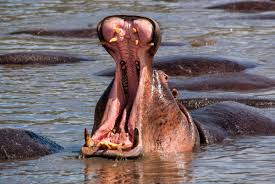
 Nile Crocodile: Nile crocodile is the largest reptile and can grow up to 21 feet. Females are smaller than their male counterparts. Males can weigh up to 1200 Kg depending upon location and habitat.
Nile Crocodile: Nile crocodile is the largest reptile and can grow up to 21 feet. Females are smaller than their male counterparts. Males can weigh up to 1200 Kg depending upon location and habitat.
These crocodiles have a wide and are opportunistic hunters and prefer river deltas, mangrove swamps as their habitat.
They are considered, as one of the largest and fiercest amongst all the crocodiles. They submerge themselves underwater and approach their prey silently then pounces on them with the strongest bite force. They have sharp conical teeth that sink into the muscles effectively.
Nile crocodiles are responsible for killing about 1000 people per annum. They are very fierce and aggressive. They dive for only a few minutes at a time but can swim underwater up to 30 minutes if threatened, and can hold their breath for up to 2 hours.
They are carnivorous and feed on fish, animals, insects and frogs. There have been instances of bull sharks and tiger sharks falling prey to them.
Nile crocodiles have a thick armoured scaled skin that protects them in case of attack. Aggressive and stealthy nature makes them one of the fearless animal. Once bitten by them, it is nearly impossible to come out of its jaws. There are instances of Rhino, Cape Buffalo, Giraffe and Elephants being attacked and killed by these apex predators.
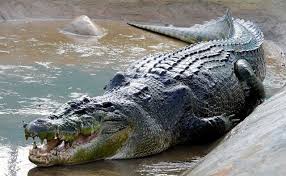
 Cape Buffalo: Cape buffalo, also known by the name of “Black Death” are the most dangerous animals. They are herbivorous animals but have a short and unpredictable temperament.
Cape Buffalo: Cape buffalo, also known by the name of “Black Death” are the most dangerous animals. They are herbivorous animals but have a short and unpredictable temperament.
They have never been domesticated due to their bad reputation. Male cape buffalos are much more muscular than the females and weigh about 1000 kgs.
They have a relatively short standing height with short and thick legs. The male buffalos have thick horns protruding upwards with a smooth curve making a shield above the base of their forehead.
They prefer open grasslands, swamps, floodplains and areas with long tall grasses. They are grazers and require daily water intake, so they flock to the water hole once or twice every day. An adult male buffalo does not have any predators.
They are more than capable, to defend themselves against the attack of any apex predators. It requires a pack of lions to bring down an adult buffalo and lions can suffer life-threatening injury for that. Crocodiles usually feed on the calf or young and prefer to stay away from adult bulls.
Cape buffalos reside in herds with females and calf at their core and the adult male bulls dominating the herd. Young males maintain their distance from the dominating bull.
The dominating bull does not allow any other bull to take charge. When threatened by any predator, all the members of the herd play their part to thwart the attackers. Distress call of a captured member draws the attention of not only calf’s mother but also of the entire herd.
Cape buffalos are responsible for the death of more than 200 people every year, by either trampling them or crushing them with their fearsome horns. The horns and the bosses of the skull take about ten years to grow fully. They are fearless animals, and their unpredictable and extremely aggressive nature makes them one of the fearless animal.
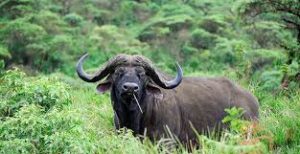
![]() Honey badger: Honey Badger is the most fearless terrestrial animal on this planet. Just don’t go by their size, they are quite capable, to take on a bunch of lions much larger than their size.
Honey badger: Honey Badger is the most fearless terrestrial animal on this planet. Just don’t go by their size, they are quite capable, to take on a bunch of lions much larger than their size.
They are carnivorous with very thick skin covered with fur and excellent defensive abilities few predators dare to take on a honey badger. The skin of honey badger is about 6mm thick and loose skin allows them to twist and turn suddenly.
They are resistant to potent venoms of snakes like king cobra or Russell’s viper. They have a short stature; about 30 inches in length having short legs with five large claws in their forelegs and hind legs with short tail weighing about 12 kgs. They are solitary animals and love to dig burrows for living and use their powerful claws for digging them.
Honey badger, as the name suggests looks for honey as their main food, and they attack beehives in search of honey. In the process, they suffer a lot of bites from bees, but that hardly affects them, as they are protected by thick skin.
They possess a distinct white fur at the top and a black fur at the abdomen and found all over the world. They are also amongst the most intelligent creatures and use tools effectively for escaping.
Honey badger is notorious for its strength, toughness, courage, ferocity and their defensive capability. They are known to steal poultry from farms, and due to their fearless nature.
They care a damn about the size or strength of their attackers. They attack fiercely and repel attacks from hyenas, lions, cape buffalos and porcupines. They tend to avoid conflicts but fiercely guard their burrows, and do not fear to attack any animal irrespective of their size.
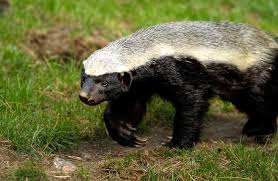




 (2 votes, average: 5.00 out of 5)
(2 votes, average: 5.00 out of 5)


